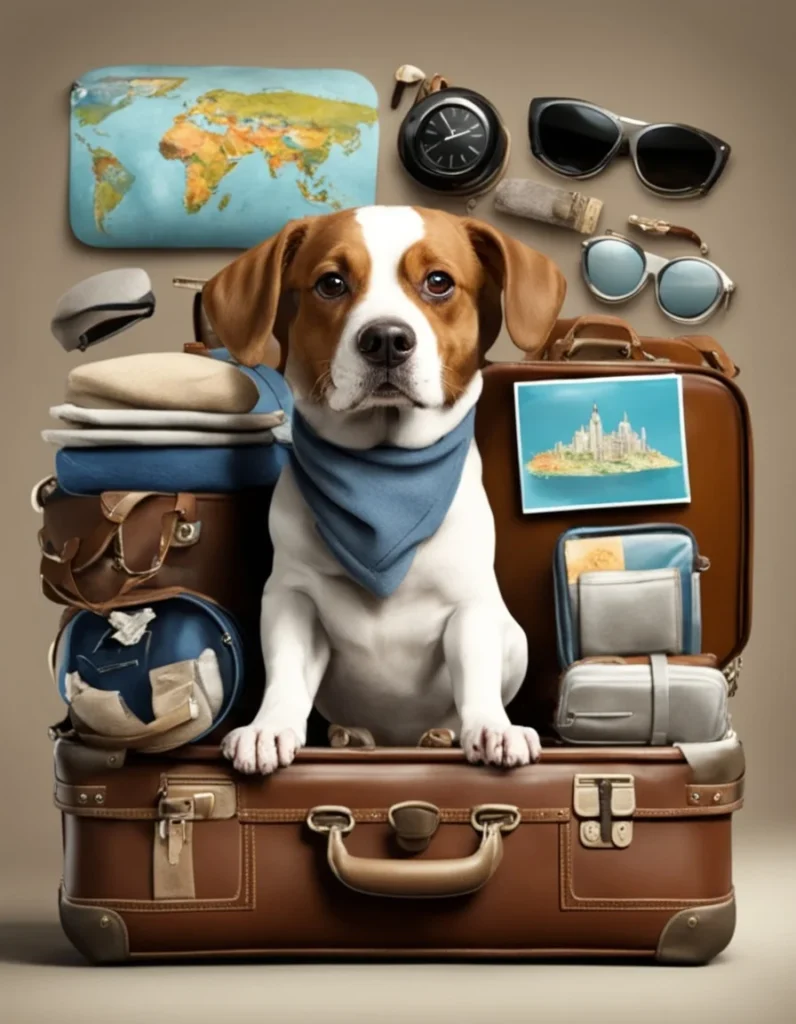Vacations in Spain with your dog
Vacations in Spain with your dog
Vacations in Spain with your dog
Vacations in Spain with your dog
26. August 2024
Feedback: 0
Planning a trip to Spain and don’t want to leave your beloved four-legged friend behind? Great decision! Spain is a fantastic destination for travelers with dogs—if you’re well-prepared. In this guide, you’ll learn everything you need to know to make sure your vacation is as relaxing for you and your dog as you hope.
- Travel Preparations – What Does Your Dog Need?
- Potential Hazards
- Traveling – On the Go with Your Dog
- Accommodation – Where Is Your Dog Welcome?
- Beaches – Where Can Your Dog Swim?
- Leash Laws and Dog Regulations – What Are the Rules?
- Climate – Heat Waves in the South
- Veterinary Care – Being Prepared for Emergencies
- Breed Restrictions – Be Aware of Certain Breeds
- Food and Supplies – What Will Your Dog Eat?
- Conclusion: Well-Prepared for a Relaxing Vacation in Spain
Travel Preparations – What Does Your Dog Need?
Before you set off, there are a few important things you need to take care of to ensure your dog is ready for the trip to Spain. Top of the list is the EU pet passport. Without this document, traveling can get tricky, as it’s required for all trips within the EU. Your dog must have a valid rabies vaccination listed in the passport, administered at least 21 days before travel. If the vaccination was done some time ago, double-check to make sure it’s still valid—nothing would be more frustrating than being turned away at the airport or border.
Your dog also needs to be microchipped, and the chip’s information must match the details in the pet passport.
A quick vet check is also recommended: In addition to the rabies shot, it’s a good idea to check your dog’s overall health. Preventive treatments for parasites like ticks and sandflies are advisable, especially in Spain’s warmer regions.
Potential Hazards
Here are some potential risks to be aware of during your vacation in Spain:
Transmission: Through the bite of a sandfly.
Symptoms: Weight loss, skin problems, hair loss, fatigue, nosebleeds, and in severe cases, kidney failure.
Prevention: Use of special collars or spot-on treatments that repel sandflies, as well as vaccination.
Transmission: Mosquito bites carrying worm larvae.
Symptoms: Coughing, difficulty breathing, weight loss, and in severe cases, heart failure.
Prevention: Regular administration of preventive medication (tablets, spot-ons) and protection against mosquitoes.
Transmission: Through tick bites, particularly the brown dog tick.
Symptoms: Fever, weakness, anemia, yellowing of mucous membranes, and in severe cases, kidney failure.
Prevention: Use of tick repellents (collars, spot-ons) and regular checks for ticks.
Transmission: Through ticks, especially the brown dog tick.
Symptoms: Fever, fatigue, weight loss, nosebleeds, and anemia.
Prevention: Use tick repellents and regularly check your dog for ticks.
Transmission: Also through tick bites.
Symptoms: Fever, joint pain, fatigue, and loss of appetite.
Prevention: Regular use of tick prevention products and checking for ticks.
Transmission: By eating infected ticks.
Symptoms: Fever, muscle pain, weakness, loss of appetite, and nasal discharge.
Prevention: Control ticks and avoid tick infestations.
Transmission: Contact with infected dogs or their feces.
Symptoms: Vomiting, diarrhea (often bloody), loss of appetite, and fever.
Prevention: Regular vaccinations are the best protection.
Transmission: Contact with infected dogs, through airborne droplets or contaminated surfaces.
Symptoms: Fever, respiratory issues, neurological problems, and gastrointestinal issues.
Prevention: Vaccination is the best protection.
Transmission: Through bites from infected animals.
Symptoms: Behavioral changes, paralysis, excessive drooling, and usually fatal.
Prevention: Rabies vaccination is mandatory in Spain, as in most parts of Europe.
Transmission: Not an infectious disease, but common during hot summer months.Symptoms: Heavy panting, drooling, weakness, confusion, and collapse
Prevention: Always provide plenty of water, plan walks during cooler parts of the day, and ensure shade is available.
Traveling – On the Go with Your Dog
Whether you’re traveling by car, train, or plane, good preparation is key. If you’re driving, your dog must be safely secured. A seatbelt or travel crate is not only important for your dog’s safety but also legally required. Your dog should also be comfortable with car rides to ensure a stress-free journey.
If you’re flying to Spain, check the airline’s pet policy in advance. Some airlines allow small dogs in the cabin, while larger dogs may have to travel in the cargo hold. This can vary depending on the airline and destination, so it’s worth checking the regulations carefully.
For train or public transport travel in Spain, dogs are often allowed, but there are rules regarding size and weight, as well as the requirement to transport your dog in a carrier.
Accommodation – Where Is Your Dog Welcome?
Finding a pet-friendly place to stay is no longer a challenge. Many hotels, vacation rentals, and campsites have embraced the idea that dogs are part of the family and offer special services for guests with dogs. A quick phone call or a check on booking platforms can help you find out if your chosen accommodation welcomes dogs.
However, some accommodations may have rules or restrictions, such as only allowing small dogs or designating certain areas as dog-free. Make sure to check in advance to avoid any surprises.
Beaches – Where Can Your Dog Swim?
Spain boasts many beautiful beaches, but not all of them allow dogs, especially during peak season. Fortunately, there are dog-friendly beaches where your pup can play and swim to their heart’s content. Regions like Catalonia, Valencia, and Andalusia have several of these beaches.
If you’re traveling in the summer, research ahead of time to find out which beaches allow dogs. Many popular beaches enforce strict no-dog policies during high season. A tip: Look for more remote or out-of-town beaches, where there are often fewer people, and the rules are more relaxed.
Leash Laws and Dog Regulations – What Are the Rules?
In most cities and urban areas, leash laws are in effect, meaning your dog must be on a leash at all times. However, in many parks and rural areas, there are designated off-leash zones where your dog can run free.
Also, keep in mind that Spain takes dog hygiene seriously. Fines for not picking up after your dog can be hefty in many cities, so don’t forget to bring enough waste bags!
Climate – Heat Waves in the South
Another important factor is Spain’s climate, particularly during the hot summer months. High temperatures can be tough on your dog. A useful tip is the „Seven-Second Test“ from Frostburg University: Place the back of your hand on the ground. If you can’t hold it there for seven seconds, the ground is too hot for your dog. Try to schedule walks for early morning or late evening and always ensure your dog has plenty of water to stay hydrated.
Additionally, make sure your dog has access to shade, especially when you’re out and about. A cool dog is a happy dog!
Veterinary Care – Being Prepared for Emergencies
Although we hope it doesn’t happen, accidents or health issues can arise while on vacation. It’s a good idea to research veterinarians and clinics near your accommodation beforehand. Spain has excellent veterinary care, and most cities have vets readily available.
If your dog requires special treatment or takes regular medication, make sure you have enough supplies for the entire trip. Pet health insurance can also be a good idea to cover any unexpected costs.
Breed Restrictions – Be Aware of Certain Breeds
Spain has strict regulations regarding so-called „dangerous dog breeds,“ which include Pit Bulls, Rottweilers, Staffordshire Bull Terriers, and a few others. If you own one of these breeds, you must take extra precautions in Spain. This includes having your dog wear a muzzle and obtaining a special permit. Be sure to research the local rules in the region you’re visiting to avoid any problems.
Food and Supplies – What Will Your Dog Eat?
When it comes to dog food, there’s no need to worry. Most supermarkets and pet stores in Spain offer a wide range of dog food. However, if your dog requires a special diet, make sure to bring enough with you or check in advance where you can purchase it locally.
Conclusion: Well-Prepared for a Relaxing Vacation in Spain
A vacation in Spain with your dog can be a wonderful experience if you’re well-prepared. From the necessary documents to finding dog-friendly accommodations to caring for your dog in the warm climate—with a little planning, nothing will stand in the way of a relaxing vacation with your furry friend. Spain offers countless opportunities for you and your dog to create unforgettable memories. So pack your bags, grab your dog, and head south!

Wir sind zwei deutsche Auswanderer und auf emigres-life nehmen wir Dich mit auf unsere Reise in ein neues Leben.
In unserem Projekt schwingt das Pendel meist in Richtung stressig oder chaotisch und weniger in Richtung tiefenentspannt.
Wenn du also wissen willst, in welches Fettnäpfchen wir als nächstes treten oder welche Hürden vor uns liegen und wie wir sie überwinden, dann bleib dran.
Nächster Blogpost
Kleine Hunde, große Liebe: Die 10 beliebtesten Rassen
Vorhergehender Blogpost
Spanienurlaub mit Hund: So wird es entspannt und stressfrei!



 Pin it!
Pin it!

